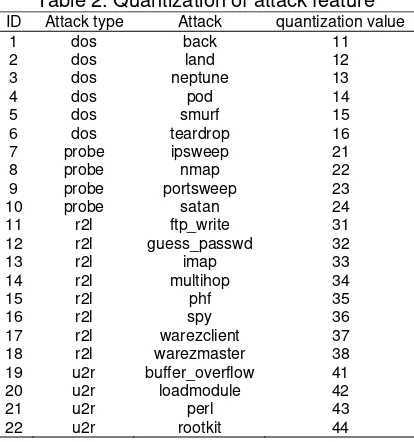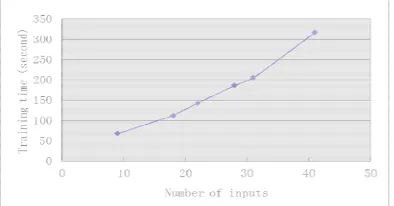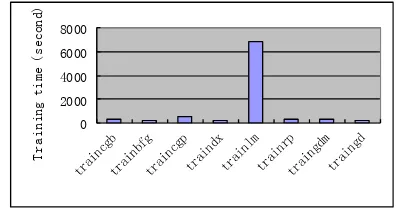DOI: 10.12928/TELKOMNIKA.v14i3A.4387 321
Design of Neural Networks for Intrusion Detection
Huiran Wang1, Ruifang Ma*2
1College of Computer Science, Xi’an Polytechnic University, Xi’an City, 710048, China 2
School of Software Engineering, Xi’an Jiaotong University, Xi’an 710049, P. R. China *Corresponding author, e-mail: [email protected]
Abstract
There are increasing demands for accessing information over the Internet, more and more networks are designed and deployed. The information and network security becomes a key issue for us to study. Neural network is effective to detect network intrusion. Much effort has been taken in this field. Stolfo et al put forward 41 higher-level derived features to distinguish normal connections from abnormal connections. Unfortunately, with these 41 derived features as inputs, IDS systems take long time to converge when training and work slowly during on-line detections. We quantize derived features to digital type before feeding them to IDS systems. We reduce the number of inputs while keeping IDS systems high detection rates. After a long time of hard work, we achieved a good architecture, i.e. 18-35-1, of BP neural network for IDS systems. And we choose trainbfg as training function.
Keywords: Intrusion detection, neural network, derived features
Copyright © 2016 Universitas Ahmad Dahlan. All rights reserved.
1. Introduction
Twenty-first centuries is the age of information, the Internet is the fastest way to get information. As a result, more and more networks are deployed and used. With the wide spread of Internet, network security and information security is particularly important. We should study this problem deeply. Intrusion detection is an important aspect of network security. Neural network is an effective tool for intrusion detection. Many scholars have carried out in-depth research in this field [1, 2]. Stolfo et al [3] put forward 41 higher-level derived features to distinguish normal connections from abnormal connections. These features are grouped into four kinds, i.e., basic features, content features, time-based traffic features, and host-based traffic features. Many researchers use these features to study intrusion detection method, and obtained detection rates up to 91% with false positive rates less than 1% [4, 5].
Nevertheless, with these 41 features as inputs, IDS systems converge slowly. We try to reduce the number of features to IDS systems.
2. BP Neural Network
3. Quantization of Derived Features
Derived features fall into three data types, i. e., continuous type, discrete type, and symbolic type. Symbolic type of derived features cannot be feed directly to IDS systems. We have to quantize them to digital type. Three features and attack types belong to symbolic data type. We assign a digital value to each value of the features with symbolic data type. During quantization of protocol feature, we give three digital value to tcp, udp and icmp respectively as shown in Table 1. We assign similarly 10 digital values to flag feature, 70 digital values to service feature.
Table 1. Quantization of protocol feature ID Original value Quantization value
1 TCP 1
2 UDP 2
3 ICMP 3
In regard to quantization of network attack, the digital values consist of two parts, one part of which presents the attack type, and the other the attack itself as shown in Table 2.
Table 2. Quantization of attack feature ID Attack type Attack quantization value
1 dos back 11
19 u2r buffer_overflow 41
20 u2r loadmodule 42
21 u2r perl 43
22 u2r rootkit 44
4. Features Inputting to IDS Systems
Now, more and more people use the internet. Traffic data grows fast since extensive use of the Internet. Choices of adapted features inputting to an IDS system are important for the success of these IDS systems. In traditional solutions [4, 6], nine elements of network packets are fed to IDS systems as input features. These elements contain network protocol, source port number, destination port number, source IP address, destination IP address, ICMP type, ICMP code, raw bytes length, and raw bytes.
Another element (Attack) was added to each record according to whether this connection represented an attack on a network.
However,with so many features as inputs, IDS systems take long time to converge while training and work slowly during on-line detections. Our purpose is to reduce the number of inputs and keep IDS systems high detection rates.
We construct different architectures of BP neural networks with different input number. In the hidden layer, we make use of tansig [7] as transfer function. In the output layer, logsig is employed as transfer function. As the training function, we utilize trainrp (Resilient Backpropagation). Network traffic data has a total of 2109 records. The calculation environment is as following: Dell Precision 3000, Intel 6th Gen Core™ i7 6700 CPU, 16GB 2x8GB 2133MHz DDR4 ECC UDIMM RAM, 4000 GB SATA 5900RPM HD, Windows 7 profession Edition.
From Figure 1, we understand that the detection rates vary with number of inputs, but the fluctuation is relative small. From Figure 2, we know that the training time increase rapidly with the number of input.
Figure 1. Detection rate vs input number Figure 2. Training time vs input number
Based on the above fact, we come to conclusion that the best value for input number is 18. In other words, we should take 9 basic features and 9 time-based features as inputs to IDS systems. Taking features as inputs, the IDS system reaches a higher detection rate (over 88%) and the training time is still shorter (about 120 seconds).
5. Design of Architecture of IDS Systems
According to Kolmogorov theorem, we may utilize a 3-layer neural network n-u-m in IDS systems. Where, n represents the input number, m represents the output number. As presented in section 4, 18 is a good choice for input number. The output of an IDS system is designed to show whether there is any intrusion at given time. One output for IDS system is a better solution [9]. In this section, we focus our attention on the determination of the node number at the hidden layer.
We experimented with different node number in the hidden layer. The calculation environment is the same as in section 4. The detection rate vs. node number in hidden layer is shown in Figure 3. This figure indicates that the detection rate reaches a maximum at the point where the node number u in hidden layer equals to 35 [10-12].
6. Results and Analysis
We train our “good” architecture of 18-35-1 BP neural networks with various training functions. After 2500 epochs, we got the training time shown in Figure 4 and the mean square error illustrated in Figure 5.
Figure 3. Determination of node number in the hidden layer
Figure 4. Training time vs. training functions
Figure 5. Mean square error vs. training functions
7. Conclusions
We quantize derived features to digital type before feeding them to IDS systems. After simulation, analysis and experiment, we reduced the input number from 41 to 18, and obtained a “good” architecture, i.e. 18-35-1, of BP neural network for IDS systems. We choose trainbfg as training function. With this architecture, the IDS system gives a shorter training time and reaches higher detection rate.
Acknowledgements
This work is supported by a research project of The Science and Technology Bureau of Xi’an Beilin District (No.GX1607).
References
[1] Yang YH, Huang HZ, Shen QN, Wu ZH, Zhang Y. Research on Intrusion Detection Based on Incremental GHSOM. Chinese Journal of Computers. 2014; 37(5): 1216-1224.
[2] HU Mingxia. Intrusion Detection Algorithm Based on BP Neural Network. Computer Engineering. 2012; 38(6): 148-150.
[3] Stolfo J, Wei F, Lee W, Prodromidis A, Chan PK. Cost-based modeling and evaluation for data mining with application to fraud and intrusion detection. Results from the JAM Project by Salvatore. 1999.
[4] Pan ZS, Chen SC, Hu GB, Zhang DQ. Hybrid neural network and C4.5 for misuse detection. IEEE
The Second International Conference on Machine Learning and Cybernetics. 2003.
[5] Kayacýk HG, Zincir-Heywood AN, Heywood MI. Selecting Features for Intrusion Detection: A Feature Relevance Analysis on KDD 99 Intrusion Detection Datasets. Third Annual Conference on Privacy, Security and Trust. Canada. October. 2005: 12-14.
[6] Cannady J. Artificial Neural Networks for Misuse Detection. Proceedings National Information
systems Security Conference (NISSC'98). Arlington VA. Oct.1998: 443-456.
[8] Abdar M, Kalhori SRN, Sutikno T, Subroto IMI, Arji G. Comparing Performance of Data Mining Algorithms in Prediction Heart Diseases. International Journal of Electrical and Computer Engineering (IJECE). 2015; 5(6): 1569-1576.
[9] Dadkhah M, Obeidat MM, Jazi MD, Sutikno T, Riyadi MA. How can we identify hijacked journals?
Bulletin of Electrical Engineering and Informatics. 2015; 4(2): 83-87.
[10] Zhou Y, Yang J. Application of Matlab in Intrusion Detection Systems. Journal of Shandong University. 2003; 12: 92.
[11] Yan X, Wu Q, Zhang C, Li W, Chen W, Luo W. An improved genetic algorithm and its application.
Indonesian Journal of Electrical Engineering and Computer Science. 2012; 10(5): 1081-1086. [12] Susanto BM. Naïve Bayes Decision Tree Hybrid Approach for Intrusion Detection System. Bulletin of


